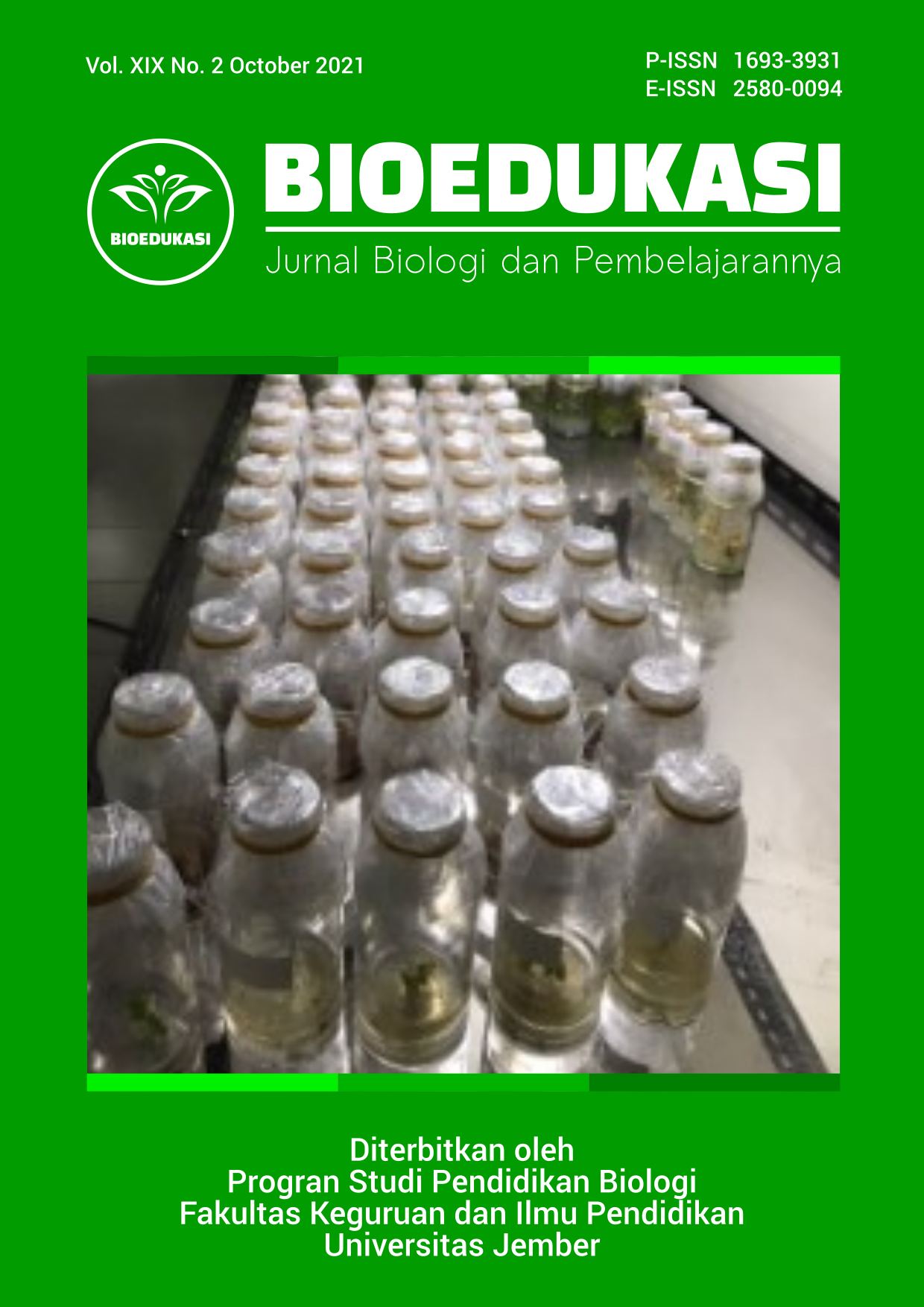THE PHYTOREMEDIATION POTENTIAL OF LOTUS: DEGRADATION BOD AND COD LIQUID COFFEE WASTE
DOI:
https://doi.org/10.19184/bioedu.v19i2.26768Keywords:
BOD, COD, Phytoremediation, Liquid Coffee Waste, LotusAbstract
Liquid coffee waste has the main component in the form of organic matter which is very resistant to increasing pollutant loads. Preliminary research results show that the level of pollution exceeds the quality standard with the test results of 23 ppm BOD and 72 ppm COD, so we need a way to prevent pollution. One way that can be used is the phytoremediation method by utilizing plants as pollutant degrading agents. The purpose of this research was to determine the effectiveness of lotus in degradation of BOD and COD of liquid coffee waste. The research method used an experimental method with a Completely Randomized Design consisting of four variations of lotus biomass 0 g, 25 g, 50 g, and 75 g with three replications within 6 days. The results showed a degradation of BOD and COD levels varied. The most effective treatment for lotus phytoremediation on day 3 was P3 with a biomass of 75 g resulting in a degradation of BOD and COD reaching 72% and 71% which met the PP RI No. 82/2001 with a maximum limit of 3 ppm BOD and 25 ppm COD. The results of the homogeneity of variance test showed that the four treatments had homogeneous variance and analysis of variance showed that F count > F table 5% (4.07) and > F table 1% (7.59). These results indicate that lotus is effectively used as phytoremediation of liquid coffee waste. The conclusion of this research is that lotus is effective in BOD and COD degradation of liquid coffee waste.
Downloads
References
Atima, W. (2015). BOD dan COD Sebagai Parameter Pencemaran Air dan Baku Mutu Air Limbah. Jurnal Biology Science & Education, 4(1), 99–111.
Hanafiah, K. A. (2008). Rancangan Percobaan Aplikatif. Aplikasi Kondisional Bidang Pertamanan, peternakan, Perikanan, industri, dan Hayati. Jakarta: PT. Raja Grafindo Persada.
Irhamni. (2020). Efektifitas Tumbuhan Air Dalam Menyerap Logam Berat (Cr, Hg, Pb) secara Fitoremediasi Pada Lindi Tempat Pembuangan Akhir Kota Banda Aceh (Doctoral dissertation). Program Pascasarjana Universitas Sumatera Utara, Medan.
Karnain, Ramadhiantie. (2016). Hubungan Evaporasi Terhadap Pertumbuhan Tanaman Teratai Putih (Nymphaea alba). Skripsi. Universitas Sumatera Utara.
Khaer, A., & Nursyafitri, E. (2019). Kemampuan Metode Kombinasi Filtrasi Fitoremediasi Tanaman Teratai Dan Eceng Gondok Dalam Menurunkan Kadar BOD Dan COD Air Limbah Industri Tahu. Sulolipu: Media Komunikasi Sivitas Akademika Dan Masyarakat, 17(2), 11.
Mahyatun, W. O., Samang, L., & Zubair, A. (2014). Fitoremediasi Logam Cd Menggunakan Kombinasi Eceng Gondok dan Kayu Apu dengan Aliran Kontinyu. Repository Universitas Hasanuddin, 1–12.
Manik, K.S.E. (2016). Pengelolaan Lingkungan Hidup. Jakarta: Prenamedia Group.
Muhajir, M. S. (2013). Penurunan Limbah Cair BOD dan COD pada Industri tahu Menggunakan Tanaman Cattail (Typha agustifolia) dengan Sistem Constructed Wetland. Skripsi. Universitas Negeri Semarang.
Nindra, D. Y., & Hartini, E. (2015). Efektivitas Anaman Teratai (Nympahea firecrest) dan Eceng Gondok (Eichhornia crassipes) Dalam Menurunkan Kadar Biochemical Oxygen Demand) Pada Limbah Cair Industri Tahu. VISIKES: Jurnal Kesehatan Masyarakat, 14(2), 123–130.
Ningsih, D. A. (2017). Uji Penurunan Kandungan BOD, COD, dan warna Pada Limbah Cair Pewarnaan Batik Menggunakan Scirpus grossus dan Iris pseudacorus dengan Sistem Pemaparan Intermittent. Skripsi. Institut Teknologi Sepeluh November.
Raras, D. P., Yusuf, B., Kalimantan, M., & Dalam, T. (2015). Analisis Kandungan Ion Logam Berat ( Fe , Cd , Cu dan Pb ) pada Tanaman Apu-Apu ( Pistia Stratiotes L ) dengan Menggunakan Variasi Waktu. Prosiding Seminar FMIPA. Universitas Mulawarman.
Rukmawati, B. S. (2015). Perbaikan Kualitas Limbah Cair Pengolahan Kopi Menggunakan Sirkulasi Pada Proses Fitoremediasi. Skripsi. Universitas Jember.
Rukmi, D. P. (2014). Efektivitas Eceng Gondok (Eichhornia crassipes) Dalam Menurunkan Kadar Deterjen, BOD, dan COD Pada Air Limbah Laundry. Skripsi. Universitas Jember.
Sariadi. (2011). Pengolahan Limbah Cair Kopi dengan Metode Elektrokoagulasi secara Batch. Jurnal Teknik Kimia, 72–76.
Soemirat, Slamet. (2009). Kesehatan Lingkungan. Yogyakarta: Gadjah Mada University Press.
Suprihatin, H. (2014). Kandungan Organik Limbah Cair Industri Batik Jetis Sidoarjo dan Alternatif Pengolahannya. Skripsi. Institut Teknologi Pembangunan Surabaya.




 https://orcid.org/0000-0003-1920-0515
https://orcid.org/0000-0003-1920-0515